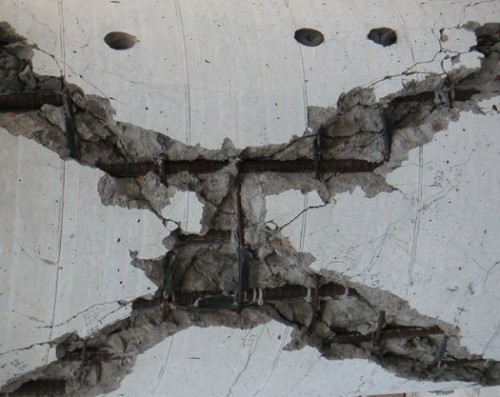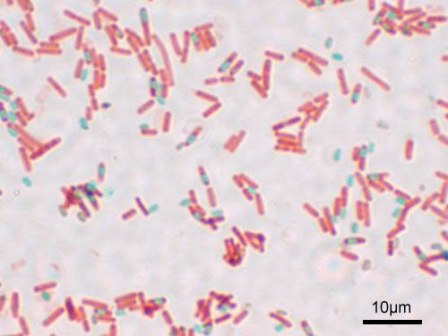BacillaFilla: Bacteria that Repair Cracked and Damaged Concrete
Joints are like an after-school program for cracks in concrete. If we fail to provide a place for cracks to occur safely, under supervision, and in aesthetically pleasing configurations, we as a society will be faced with complete anarchy in our walls and slabs. This horrifying chaos could lead to unwed, underage cracks begetting more cracks and, possibly even more alarming, cracks on crack.
Sometimes, despite the provision of joints and reinforcing in concrete to resist tension, construction goes horribly wrong. Say the mix is off, or the wrong strength is used by mistake, or perhaps someone throws an empty can on the ground and it rolls into the formwork whereupon it gets cast into the underside of the slab, weakening it in a place where it ought to be strong. Or imagine if something were to explode unexpectedly, blasting a wall with forces it wasn’t designed to resist. Concrete is a pretty forgiving medium but there are limits. In any of these situations cracks can start to form that either weaken a structure or at the very least damage it aesthetically.
Image courtesy popsci.com
Until recently the solution to a lot of these crack problems was rehab – tearing out the offending concrete and recasting or patching it -usually an expensive proposition. Sometimes people drip high-strength epoxies into the cracks hoping the glue will hold everything together, but this tactic engenders a new set of problems. For example, if the glue is stronger than the concrete it puts a whole new set of stresses on the material.
Now there is another way. Researchers at the University of Newcastle in the UK have invented a bio-based material that patches up the cracks in concrete structures, restoring buildings damaged by seismic events or that have deteriorated over time. They’ve “custom-designed a bacteria to burrow deep into the cracks in concrete where they produce a mix of calcium carbonate and a special bacteria glue that hardens to the same strength of the surrounding concrete” (Dillow). That’s right, people. Bacteria glue to the rescue!
Image courtesy en.citizendium.org
“BacillaFilla,” as the researchers call it, is a genetically modified version of Bacillus subtilis. Apparently Bacillus subtilis (what a great name for a bacteria by the way – it sounds unobtrusive and subtle and as though it’s found below tiles) is everywhere around us and easily encountered in common soil. The Newcastle researchers “have tweaked its genetic properties such that it only begins to germinate when it comes in contact with the highly-specific pH of concrete. Once the cells germinate, they are programmed to crawl as deep as they can into cracks in the concrete, where quorum sensing lets them know when enough bacteria have accumulated” (Dillow).
When the bacteria reach the deepest part of the crack and their spidey sense tells them they’ve reached an appropriate population size, they start to morph. The cells begin to develop bacterial filaments, to produce calcium carbonate, and to “secrete a kind of bacterial glue that binds everything together. Once hardened, the bacteria is essentially as strong as the concrete itself, restoring structural strength and adding life to the surrounding concrete. The bacteria also contains a self-destruct gene that keeps it from wildly proliferating away from its concrete target, because a runaway patch of bacterial concrete that continued to grow despite all efforts to stop it would be somewhat annoying” (Dillow). So unlike the brute force approach of tearing out an entire zone of concrete, or the “coat everything with epoxy and cross your fingers” route, BacillaFilla has a kind of emergent intelligence that lets it assess and repair each unique crack.
BacillaFilla could be used to improve the longevity of concrete structures, which means we’d need to build fewer of them. That’s bad news for architects but good news for the planet because a lot of energy goes into the production of new concrete. The material might also be deployed where earthquakes have damaged buildings, reducing the number of structures that would need to be torn down. I also wonder if the bacteria could be tweaked so as to first build concrete structures and then maintain them over time?
I’m filing BacillaFilla under earth because they’re living in the soil and etc.
Cited:
Dillow, Clay. “Bacteria Can Fill Cracks in Aging Concrete.” Popsci.com. 11/16/10. Accessed 11/30/10. URL.

















[…] This post was mentioned on Twitter by Alli Dryer, Cole Design Studio. Cole Design Studio said: BacillaFilla: Bacteria that Repair Cracked and Damaged Concrete: Joints are like an after-school program for c… http://bit.ly/i5ndIU […]
It is potentially very promising that a bio-based material can patch up the cracks in concrete structures. This could make concrete repair faster, cheaper and more sustainable.
hi……v r planning to do a project on this topic but v r not clear how to add the bacteria in the concrete and what percentage amount of bacteria should be induced in concrete ????and how to test it?? so kindly give us some guidance
what! so cool!
Leave a Wordpress Comment:
Ads
Watch ARCHITERIALS Videos on vimeo
Like on Facebook
Twitter
Flickr
Hit Counter
Ads
Blogs
Green
Journals/Publications
Materials
Network/News
Offices/People
Resources
Science
Pages
Archive
RSS and Email Subscriptions
Tag Cloud
3D 3D printer AB FAB academic acid acrylic actuated matter adaptive adhesive adsorption aerogel air air conditioning alloy aluminum amnh antibacterial antifungal ants april fool's architecture architecture robot artificial skin autonomous aviation awesome bacteria bamboo bananas beer bench bend bending biennale biocomputing biodegradable biodegradeable biomaterials biomimetics biomimicry biominerals biopolymer birds blast blast-resistant block blocks blogs Bloom Box brazil brick bubbles bucky bulk metallic glass butterfly calera canvas carbon carbon fiber carbon nanotubes carpet cars ceiling cellulose cement ceramic chain link chair charcoal charlie sheen chemicals chiller clay cloth cloud cmu coils color color-changing communication compound computer concrete condensation conducting conductive context cool coral cracks crystal cyborg demakersvan design digifab dirt disaster dna dror drywall dutch dynamic EAP earth ecocradle ecolect e coli ecology ecoresin ecovative elastic electric electricity electrochromic electroluminescent electronic energy energy recovery environment evaporative cooling experiment fabric fabrication facade fiber fiberglass fiber optic fiber optics fibers film FIRE flexible flickr fly ash foam fungus furniture garbage gel geodesic dome geometry gfrp gilgamesh glass glass fiber glow glue gold graphene green greensulate gsapp gypsum hard heat heavy heidi klum helix hemp hexagon hidden high performance hive honeybee humidity ice India ink insulation interference Internet inventables invisible invisible ink jello jellyfish just add water kevlar kinetic korea lace lamboo laser lattice leaves LED leed LEGO light light emitting light transmitting liquid lo mein london Loop.pH machines magic magnetic marine material materials meatball melting memory metabolic engineering METAL metal panel metamaterial micro microsensor microtools military milk MIT moisture multi-layer mushrooms mycelium nano nanogel nanotech nanotubes NASA new noise non-metallic oil OLED OMA ostrich oysters packaging paint panel panels paper paperfoam paraffin wax particles particulates petroleum phase change phosphorescent pink PLA plastic platinum pm-10 poetry pollution polymer polymers porcelain power precast printed printing protein public quadror radiant rain rammed earth reclaimed recycled reflective refracting Rem Koolhaas resin robot robotics roof rubber rugged sand sealant sealer search segmented self-healing sensor shape memory silica silicon silk skin skittles slats smog soft solar solar cell solar cells solar paint solid solid state lighting sound spider spider glue spray stabilized sand stone stretch stretchable strong structural structure studio dror sun sunglasses super supercritical sustainable switzerland tags tape technology TED tensile TEXAS textile textiles texture thermal thermochromatic thin thin film thread tiger stone tile tiles timber tio2 tires toaster tokujin yoshioka touch touch-sensitive toxic transparent t shirts tulip ultra-thin university of akron university of connecticut upcycling virus voc wall wallpaper WATER web wet whale wires WOOD woodwool wool workshop
WP Cumulus Flash tag cloud by Roy Tanck and Luke Morton requires Flash Player 9 or better.
Recent Comments
Ads
Recent Posts
Most Commented
Most Viewed